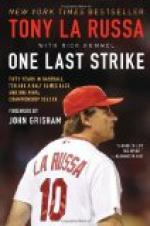Surely there was no way through that crowded field. Yet even as he studied his path a pair of blue stockings went into the air, and a threatening obstacle was out of the way, bowled over by a Harwell forward. The ends were now scouting ahead of the runners, engaging the enemy. The fifty-five-yard line was traversed at an angle near the east side of the field, and Joel saw the touch line growing instantly more imminent. But a waiting Yates man, crouchingly running up the line, was successfully passed, and the trio bore farther infield, putting ten more precious yards behind them.
The west stand was wild with exultant excitement, and Joel found himself speeding onward in time with the rhythmic sway of the deep “Rah-rah-rah!” that boomed across from the farther side. But the enemy was fast closing in about them. The Yates right half was plunging down from the long side, a pertinacious forward was almost at their heels. And now the Yates full was charging obliquely at them with his eyes staring, his jaw set, and determination in every feature and line. The hand on Joel’s shoulder dropped, Blair eased his pace by ever so little, and Joel shot forward in the track of the full, his head down, and the next moment was sprawling on the turf with the enemy above him. But he saw and heard Blair and Kingdon hurdling over, felt a sharp pain that was instantly forgotten, and knew that the ball was safely by.
But the run was over at the next line. Kingdon made a heroic effort to down the half, and would have succeeded had it not been for the persevering forward, who reached him with his long arms and pulled him to earth. And Blair, the ball safe beneath him, lay at the Yates thirty-five yards, the half-back holding his head to earth.
Joel arose, and as he trotted to his position he looked curiously at the first finger of his left hand. It bore the imprint of a shoe-cleat, and pained dully. He tried to stretch it, but could not. Then he shook his hand. The finger wobbled crazily. Joel grinned.
“Bust!” he whispered laconically.
His first impulse was to ask for time to have it bound. Then he recollected that some one had said the doctor was very strict about injuries. Perhaps the latter would consider the break sufficient cause for Joel’s leaving the field. That wouldn’t do; better to play with a broken arm than not to play at all. So he tried to stick the offending hand in his pocket, found there was no pocket there, and put the finger in his mouth instead. Then he forgot all about it, for Harwell was hammering the blue’s line desperately and Joel had all he could do to remember the signals and play his position.
For the next quarter of an hour the ball hovered about Yates’s danger territory. Twice, by the hardest kind of line bucking, it was placed within the ten-yard line, and twice, by the grimmest, most desperate resistance, it was lost on downs and sent hurtling back to near mid-field. But Yates was on the defensive, even when the oval was in her possession, and Harwell experienced the pleasurable—and, in truth, unaccustomed—exultation that comes with the assurance of superiority. Harwell’s greatest ground-gaining plays now were the two sequences from ordinary formation and full-back forward. These were used over and over, ever securing territory, and ever puzzling the opponents.




